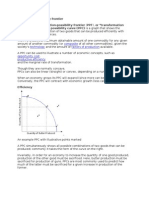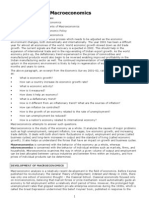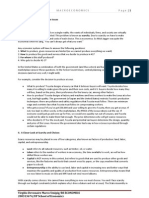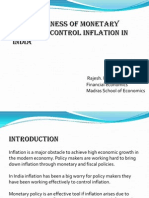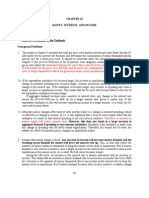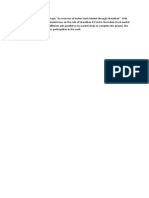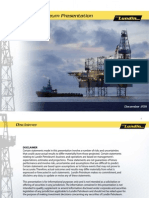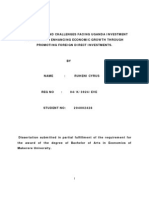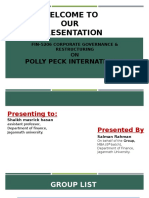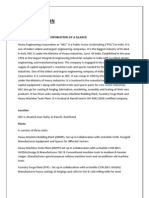Inflation and Deflation
Inflation and Deflation
Uploaded by
redsaluteCopyright:
Available Formats
Inflation and Deflation
Inflation and Deflation
Uploaded by
redsaluteOriginal Description:
Copyright
Available Formats
Share this document
Did you find this document useful?
Is this content inappropriate?
Copyright:
Available Formats
Inflation and Deflation
Inflation and Deflation
Uploaded by
redsaluteCopyright:
Available Formats
Inflation and Deflation
Inflation Causes, Types and Measures. A decrease in the value of money means an increase in the price level or an increase in the value of money means a decrease in the price level. These changes in the price level are commonly known as inflation and deflation. Inflation Inflation is a global phenomenon in present day times. It is an important and a major economic problem being faced by the developed as well as developing countries. If a slight rise in the prices of goods and commodities is accompanied by a rise in real income and economic development, then, it is not called inflation. But when prices rise, costs rise and money income rises, but real income remains constant, we say that there is inflation. Definitions of Inflation Following definitions explain the meaning of inflation 1) Prof. Crowther Every increase in the price level is inflationary and has harmful consequences for the economy. In other words, Inflation is a state in which the value of money is falling, i.e. prices are rising. 2) Friedman Inflation is always and everywhere a monetary phenomenon and can be produced only by a more rapid increase in the quantity of money than output. 3) Shapiro Inflation is a persistent and appreciable rise in the general level of prices. 4) Prof. Keynes This rise in the price level after the point of full employment is true inflation. Types of Inflation There are several types of inflation. These can be classified as under 1) Types of inflation based on speed of inflation a) Creeping Inflation When the rise in prices very slow like that of a snail or creeper, it is called creeping inflation. A sustained rise in prices of annual increase of less than 3% per annum is characterized as creeping inflation. b) Walking Inflation When price rise moderately and the annual inflation rate is 3 to 7% per annum or less than 10%, is called walking inflation. Inflation at this rate is warning signal for the government to control it before it turns into running inflation. c) Running Inflation When prices rise a rate of speed of 10 to 20% per annum, it is called running inflation. Such an inflation affects the poor and middle classes adversely. It requires strong monetary and fiscal measures, otherwise it leads to hyperinflation. d) Galloping or Hyper Inflation When prices rise very fast at double or triple digit rates from more than 20 to 100% per annum or more, it is called galloping inflation.
When rate of inflation becomes immeasurable and absolutely uncontrollable, such a situation brings a total collapse of the monetary system because of the continuous fall in the purchasing power of money. 2) Demand pull and cost push inflation When the effective demand for goods and services in an economy exceeds the existing supply of goods and services, prices tends to rise and result in the demand pull inflation. When the economy is operating at full employment level, an increase in the volume of money supply leads to demand pull inflation. An increase in the volume of money causes fall in the rate of interest and a rise in the investment. As a result the money income of various factors also rises leading to an increase in the effective demand. The supply of gods and services cannot be increased as the economy is operating at a full employment level. The higher money income pull up prices. This is called demand pull inflation. Cost push inflation may be caused by increased wages of organized workers or an attempt on the part of the industrialists to push up their profit margins. Sometimes, inadequate supply of raw material or obstacles in the transport also leads to cost push inflation. Finally, higher cost of production resulting in the rise in the prices. 3)Classification on inflation based on time period a) Peace time inflation During peace time, as a result of governments expenditure on ambitious projects or unproductive purposes, inflation takes place. b) War time inflation During war period, huge expenditure on defense creates inflation. c) Post war inflation It takes place immediately after war because of relaxation of price and physical controls by the government. The pent up demand finds open expression causing inflation. 4)Classification of inflation based on causes of inflation a) Currency inflation This is the classic type of inflation marked by an excess supply of money in relation to the available output of goods and services. b) Credit inflation When the government encourages an expansion of credit without expanding the supply of money in circulation, it is called as credit inflation. c) Profit induced inflation Due to various reasons production costs start declining and consequently, the prices also show a declining trend. But the government does not allow the prices to fall down by restoring the artificial means. In such a situation, the prices do not go up at the same time they are not allowed to fall down. This situation results in an increase in the profit of producers. d) Deficit induced inflation When there is considerable decrease in the direct taxes or increase in the direct taxes, it leads to fiscal inflation. Deficit induced inflation is the result of deficit financing.
e) Wage induced inflation When trade unions succeed in increasing their wages, it affects on production cost. Due to increasing production cost, prices of goods and services rise upward. This may be referred to as wage induced inflation. f) Scarcity induced inflation When the supply of goods decreases on account of various reasons, prices shows an upward trends. This may be called scarcity induced inflation. 5) Classification of inflation based on comprehensiveness of inflation When prices of every commodity throughout the economy rise it is called economy wide or comprehensive inflation. When the prices of a few commodity rise upwards on account of certain physical bottlenecks, it is known as sporadic inflation. 6) Classification of inflation based on Governments control on inflation When the government does not attempt to prevent a price rise, inflation is said to be open. When the government interrupts price rise through adoption of certain measures it is repressed or suppressed inflation. Causes of Inflation A) Factors causing an increase in demand - Following factors cause an increase in demand 1) Increase in public expenditure Government activities have been expending much with the result that government expenditure has also been increasing at a phenomenal rate, thereby raising aggregate demand for goods and services. In fact, this is an important cause giving rise to the emergence of excess demand in the country. 2) Increase in private expenditure When the business conditions are good, private businessmen are eager to spend more money on capital goods. This increases the demand for capital goods, and in turn, brings about an increase in the demand for consumers goods. This is because there is an increase income of factors production which increases demand for goods and services. It results in the prices of goods leading to inflation. 3) Increasing in consumer spending The demand for goods and services increases, when consumer expenditure increases. Consumers may spend more due to conspicuous consumption or demonstration effect. They may also spend more when they are given credit facilities to buy goods on hire purchase and installment basis. 4) Increase in money supply The higher the growth rate of the money supply, the higher the rate of inflation. 5) Monetary policy When the government adopts cheap money policy, it results in increasing purchasing power in the hand of the people. It increases demand for goods and services which results in inflation. Reduction in the bank rate, buying of securities
in the open market, repayment of the public debt; all these leads to increase in money supply and credit supply. This results into inflation. 6) Deficit financing In order to meet rapidly expenditure, the government resorts to deficit financing. This raises aggregate demand in relation to aggregate supply of goods and services, thereby leading to inflationary rise in prices. 7) Reduction in taxation If there is a reduction in the taxes levied by the government, people are left with more money, which can be spent. This increases their expenditure, as well as the prices of commodities. 8) Repayment of public debt Whenever the government repays its past internal debt to the public, it leads to increase the money supply with the public. This tends to raise the aggregate demand for goods and services. 9) Increase in exports When there is an increase in the domestic goods export, this raises the earnings of industries producing export commodities. These in turn, create more demand for goods and services within the country. 10) Black money Due to corruption, tax evasion there is increase in black money. This increases the disposable income of the people. It increases the demand for goods and services, whereby the problem of inflation emerges in the country. B) Factors causing a Decrease in Supply - Following are the factors which result in a reduction in the supply of goods and services. 1) Shortage of factors of production One of the important causes affecting the supplies of goods is the shortage of factors of production such as labour, raw material, capital, land, power supply etc. They lead to excess capacity and reduction in the industrial production. 2) Industrial disputes The powerful trade unions use the measures like strikes, which curtail the production of goods and services. As a result, the prices rise and the problem of inflation emerges. 3) Natural calamities There are various types of natural calamities which may reduce production. Natural calamities like flood, drought, earthquake, etc. disturb the productive sector and curtail the supply of goods and services. As a result, their prices rise and inflationary situation takes place. 4) Trade policy Governments defective trade policy increases export of goods and services or decreases import of goods and services. This also causes inflation. 5) Artificial scarcities Artificial scarcities are created by hoarders and speculators who indulge in black marketing. Thus they are instrumental in reducing supplies of goods and raising their prices. 6) Lopsided production The demand for luxurious goods increases as a result of unequal distribution of national income. Producers invest their capital in such production. So the production of essential good is reduced which creates inflation. 7) Diminishing returns to scale The state of diminishing returns in the productive sectors of economy raises cost per unit of production, thereby prices rise and inflation emerges.
8) Traditional production technique Traditional production technique and absence of proper maintenance reduces production and become cause of inflation. Effects of Inflation The effects of inflation can be discussed under three sub heads 1) Effects on production, 2) Effects on distribution and 3) Other effects. 1) Effects on Production The effects of inflation on production are a) Misallocation of Resources Inflation causes misallocation of resources when producers divert resources from the production of essential goods from which they expect higher profit. b) Changes in the system of transactions Inflation leads to changes in transactions pattern of producers. They hold a smaller stock of real money holding against unexpected contingencies than before. They devote more time and attention to converting money into inventories or other financial or real assets, in this process some resources are used wastefully. c) Reduction in production It is the mild inflation and the state of underemployment which increases production of goods and services with the rise in prices. But intensive inflation adversely affects the volume of production because the expectation of rising prices along with rising costs of inputs brings uncertainty. This reduces output. d) Fall in quality During the period of rising prices, there is a scarcity of goods and services on a very large scale. In such a situation, producers, produce and sell substandard commodities in order to earn higher profits. They also indulge in adulteration of commodities. e) Hoardings and black marketing To earn more and more profits, the producers hoard stocks of their commodities. They sell their output in black market. f) Reduction in saving In the period of rising prices, the propensity to save declines, because more money is needed to buy goods and services than before. Reduced saving adversely affects investment and capital formation. As a result, production is hindered. g) Speculation The worst part of inflation is that it gives stimulus to speculative activities on account of the uncertainty generated by a continually rising price level. h) Working of price mechanism The most serious effect of inflation is that it disrupts the smooth working of the price mechanism, thereby creating an all round confusion in the economy. 2) Effects on Distribution The effects of inflation on distribution are a) Creditors and Debtors During the period of rising prices, creditors are put to losses because when prices rise the value of money falls. Though debtors return the same amount of money, they pay less in terms of goods and services. Thus the burden of the debt is reduced and debtors gain.
b) Salaried persons Salaried persons like clerks, teachers and other white collar persons lose when there is inflation. The reason is that their salaries are slow to adjust to rising prices. c) Wage earners They lose during inflation because after full employment, they do not get adequate employment. Likewise, their wages do not rise in production to rising prices. d) Fixed income groups The fixed income groups are the hardest hit during inflation, because their incomes, being fixed, do not bear any relationship with the rising cost of living. e) Investors Investors in fixed interest yielding bonds and debentures are affected adversely as they get fixed income. On the other hand, investors in equities (shares), real assets are the gainers. f) Farmers Generally, farmers are the gainers during inflation. The prices of agricultural goods rise while costs incurred by them do not riseupto the same extent. In India a larger number of farmers returned loans due to post war inflation. Moreover, the farmers are generally debtors so they are gainers during inflation. g) Government In a country where the share of public sector is large, inflation affects government expenditure to a great extent. Government has to pay higher payments to its workers and raw material used in the public sector. The government has to resort to deficit finance to meet the increased public expenditure. 3) Other Effects Inflation leads to a number of other effects which are discussed as under a) Balance of payments Inflation results in rising imports and fall in exports, which creates the state of deficit in balance of payments. b) Financial institutions When inflation is limited, bank, insurance companies and other financial institutions get an advantage because their activities are boosted. But as soon as prices begin to rise at a faster rate, the savings of the people are reduced, and most of the financial institutions fall in trouble. c) Exchange rate When prices rise more rapidly in the home country than a foreign countries, it lowers the exchange rate in relation to foreign currencies. d) Collapse of monetary system If hyperinflation persists and the value of money continues to fall many times in a day, it ultimately leads to the collapse of the monetary system, as happened in Germany after 1st World War. e) Political Rising prices encourages agitation and protests by opposition parties against the government. This may bring the downfall of the government. f) Social Inflation is socially harmful. It increases the gap between poor and rich people. People resort to hoarding, black marketing, adulteration, speculation, corruption and production of sub standard goods. This creates class conflict, social tensions and social instability.
Measures to Control Inflation The above discussion, thus, highlights the necessity of quick, prompt and effective action to check and control the inflation. There are three types of measures for controlling inflation. A) Monetary Measures These measures are adopted by the Central Bank of the country. These are, 1) To increase bank rate 2) To increase cash reserve ratio 3) Sale of Government securities in the open market 4) Consumer credit control 5) Higher margin requirement 6) Direct control on credit supply 7) Moral suasion B) Fiscal Measures Government can adopt following fiscal measures to control inflation. 1) To reduce the government expenditure 2) Increase in taxes 3) Increase public borrowing 4) Increasing in savings 5) Surplus budget 6) Debt management 7) Overvaluation Like the monetary measures, fiscal measures alone cannot help in controlling inflation. They should be supplemented by monetary, non monetary and non fiscal measures. C) 1) 2) 3) 4) 5) 6) 7) Other Measures To increase production Wage policy Price control and rationing Public distribution of food grains through fair price shops Avoiding export of essential goods Import of essential goods Avoiding deficit financing
From the various monetary, fiscal and other measures discussed above, it becomes clears that to control inflation, the government should adopt all measures simultaneously.
Deflation Meaning: Deflation is completely opposite of inflation. During the period of depression, prices of goods and services decrease. The stock of finished goods increase in the go down and the volume of output is reduced. It leads to unemployment. The meaning of the term deflation can better understand with the help of its definitions. Definitions Prof. Crowther- Deflation is that state of economy, where the value of money is rising or the price are falling. Prof. Pigou Deflation is that state of falling prices which occurs at that time when the output of goods and services increases more rapidly than the volume of money income in the economy. Prof. Paul Einzing Deflation is a state of disequilibrium in which a contraction of purchasing power tends to cause, or is the effect of decline of the price. Deflation is different from disinflation. Disinflation may be defined as the process of reversing inflation without creating unemployment or reducing the output in the economy. Deflation cannot be optional. It may be result of a deliberate government policy. It can also be due to certain natural cases. But disinflation is always optional and the result of a deliberate government policy. Causes of Deflation 1) Increase in Production When production of goods and services increases rapidly without increase in demand, as a result prices of goods and services falls. This leads to the emergence of deflation in the country. 2) Increase in Taxation When government increases the taxation to meet the need of revenue, the disposal income of the people decreases. So their consumption expenditure decreases and demand for goods and services falls. This leads to falling prices and the problem of deflation. 3) Government Policy The anti inflationary policy of the government implemented strictly for the long period restricts inflation and creates the state of deflation in an economy. 4) Credit Control Policy The credit control policy of the Central Bank consisting of quantitative and qualitative methods curtails the supply of bank money, total money supply which results in deflation. 5) Increase in Internal Public Debt Government borrows the money from the society for meeting various needs. In this process, purchasing power transfers from people to government. This results in falling demand and prices of goods and services and thereby emergence of deflation. 6) Increase in Imports The rapidly increasing imports create excessive total supply of goods and services, whereby their prices fall rapidly and persistently and deflation emerges in country.
Effects of Deflation The effects of deflation can be classified into three major categories Effects on Production Because of deflation, the values of stocks decrease. The cost of production is increased when prices are high and the products are to be sold when prices are low. This puts producers to a loss. Similarly, traders and wholesalers also incur losses, and trade and commerce is automatically reduced. The loss is luxury and durable commodities are large and their production is reduced substantially. This changes the consumption of production itself. Effects on Distribution The effects of deflation on distribution are as under Producer Producers are always adversely affected by deflation. Firstly prices fall, but costs lag behind. Secondly, raw materials and other requirements are purchased or hired at high prices and by the time finished products reach the market, prices come down further. Thirdly, there is a continuous fall in the aggregate demand. Because of this, three classes of persons i.e. traders, manufacturers and pretty businessmen suffer losses. Investors The investors who invest their money in shares are adversely affected because they do not get dividend due to losses by business activities. But those investors investing in bonds and debentures get fixed and definite income during deflation in which value of money rises continuously. Consumers The consumers are beneficially in period of deflation. Due to falling prices, the purchasing power of money rises up enabling the consumers to buy more goods and services than before. Debtors and Creditors Debtors are looser during deflation because they have to repay debts in the state of rising value of money. Creditors benefit for deflation hence they welcome this state. They extend loans at lower value of money and they get back their money at its rising value. Wage and Salary Earners The wage earners, salary earners and all other whose income is fixed, in terms of money, are benefited. The reason is that, with the fall in prices, it is not easy to cut down the wages of the workers, because trade unions are opposed to it. Hence these classes gain as a result of deflation. But when the rate of deflation is very fast, manufacturing concerns close down, lockouts are declared and this results in unemployment and employees who belong to fixed income groups suffer. Other Effects The tax payers are adversely affected by deflation. Increase in the burden of public debt. Increase in unemployment Adverse effects on banking Increasing number of disputes between the employers and the employees.
Thus deflation is very harmful for the economy. Some economists are of the view that deflation is even more harmful than inflation. In fact, both inflation and deflation are bad because both of them adversely affect the economic growth of the country. Measures to Control Deflation The following measures have been suggested to control deflation in the economy. a. Monetary Measures The following monetary measures should be adopted to control deflation. 1) Deficit financing and public welfare works can be adopted for this. It will increase purchasing power in the hands of public leading to increase in demand. 2) Reduction in interest rate In deflationary situation, the monetary authority should resort to a policy of cheap money. 3) Expansion of credit At a time of deflation, the Central Bank as well as the Commercial banks should adopt a policy of credit expansion to promote business and industry. 4) Open market operations (Purchase of securities) 5) Liberal distribution of loans. 6) Reduction in margin requirements. b. 1) 2) 3) 4) 5) Fiscal Measures Reduction in taxation Increase in public expenditure Redistribution of income and wealth in favour of the poor Repayment of public debt Grant of subsidies
c. Other Measures 1) Promotion of Exports and Reduction in Import 2) Regulation of production
You might also like
- Market FailureDocument3 pagesMarket FailureAbhishek Raj100% (1)
- PPC-production Possibility Curve, PPF-production Possibility FrontierDocument6 pagesPPC-production Possibility Curve, PPF-production Possibility Frontiertrustsiddhi62% (13)
- SMEDA Rose Water PDFDocument20 pagesSMEDA Rose Water PDFpradip_kumarNo ratings yet
- Unit 6 InflationDocument26 pagesUnit 6 InflationdawsonNo ratings yet
- Inflation DeflationDocument76 pagesInflation DeflationDeepakHeikrujam0% (1)
- Monetary Policy of Last 5 YearsDocument28 pagesMonetary Policy of Last 5 YearsPiyush ChitlangiaNo ratings yet
- Basic Macroeconomic ConceptsDocument3 pagesBasic Macroeconomic ConceptsAlexanderNo ratings yet
- InflationDocument33 pagesInflationHari prakarsh NimiNo ratings yet
- Circular Flow of IncomeDocument15 pagesCircular Flow of IncomeSakksham BehlNo ratings yet
- Inflation and DeflationDocument61 pagesInflation and Deflationjoshjeth100% (1)
- Does Monetary Policy Influence EconomicDocument12 pagesDoes Monetary Policy Influence Economicixora indah tinovaNo ratings yet
- Macro Lecture ch16 Fiscal and Monetary PolicyDocument33 pagesMacro Lecture ch16 Fiscal and Monetary PolicyKatherine Sauer100% (1)
- The Transmission of Monetary PolicyDocument4 pagesThe Transmission of Monetary PolicyPan Thet NaingNo ratings yet
- Session 1 Introduction To MacroeconomicsDocument7 pagesSession 1 Introduction To MacroeconomicsdboterNo ratings yet
- The Effects of Technological Change On Productivity and Factor Demand...Document39 pagesThe Effects of Technological Change On Productivity and Factor Demand...Mahmoud Rezagholi100% (2)
- Public Economics: Budget & Its TypesDocument24 pagesPublic Economics: Budget & Its TypesMahesh Rasal0% (1)
- The Impact of Monetary Policy On Economic Growth and Price Stability in Kenya: 1992-2013Document15 pagesThe Impact of Monetary Policy On Economic Growth and Price Stability in Kenya: 1992-2013IOSRjournal0% (1)
- Fiscal Policy NotesDocument5 pagesFiscal Policy NotesJaydenausNo ratings yet
- Development Economics - Chapter 6Document8 pagesDevelopment Economics - Chapter 6Joshua Miguel Bartolata100% (1)
- IS-LM ModelDocument6 pagesIS-LM ModelAnand Kant JhaNo ratings yet
- Economic DevelopmentDocument19 pagesEconomic Developmentsdsdawood100% (1)
- Cross-Country Comparisons of Income InequalityDocument5 pagesCross-Country Comparisons of Income InequalitySamir ParikhNo ratings yet
- Chapter - 5 Is - LM Model Econ - 102 2Document28 pagesChapter - 5 Is - LM Model Econ - 102 2abhishekNo ratings yet
- 1.2 National Income Accounting PDFDocument24 pages1.2 National Income Accounting PDFdivya91% (11)
- Monetary and Fiscal PolicyDocument18 pagesMonetary and Fiscal PolicyPradeep Ravi100% (1)
- What Is Income Inequality?Document8 pagesWhat Is Income Inequality?shikharohraNo ratings yet
- Introduction To Macroeconomics: Notes and Summary of ReadingsDocument27 pagesIntroduction To Macroeconomics: Notes and Summary of ReadingsSumon AkhtarNo ratings yet
- RBI Monetary Policy FinalDocument28 pagesRBI Monetary Policy FinaltejassuraNo ratings yet
- Eco - Ed. 429 Economics of Dev & Plan Including Added MattersDocument6 pagesEco - Ed. 429 Economics of Dev & Plan Including Added MattersHari PrasadNo ratings yet
- Macroeconomics AssignmentsDocument15 pagesMacroeconomics Assignmentsapi-3712367No ratings yet
- Development Economics NotesDocument72 pagesDevelopment Economics Notesfelipe tamakiNo ratings yet
- Economics of Welfare Lecture NotesDocument54 pagesEconomics of Welfare Lecture NotesAbhi Bhardwaj100% (1)
- Principles of Macroeconomics-LdDocument129 pagesPrinciples of Macroeconomics-Ldvlabrague6426100% (2)
- Monetarists Vs Rational E, PresentationDocument34 pagesMonetarists Vs Rational E, PresentationTinotenda Dube100% (2)
- Effectiveness of Monetary Policy To Control Inflation inDocument18 pagesEffectiveness of Monetary Policy To Control Inflation inPrem KumarNo ratings yet
- Definition of StagflationDocument5 pagesDefinition of StagflationraghuNo ratings yet
- Theory of ProductionDocument31 pagesTheory of ProductionSom AcharyaNo ratings yet
- What Is Vicious Circle of PovertyDocument5 pagesWhat Is Vicious Circle of PovertyIbrahim Vanjara100% (4)
- Kaldor Model - Group 3Document12 pagesKaldor Model - Group 3Dairy Of PeaceNo ratings yet
- Relevance of Keynesian Theory To The Current EconomicDocument15 pagesRelevance of Keynesian Theory To The Current EconomicSiva Krishna Reddy NallamilliNo ratings yet
- Macroeconomics Basic TopicsDocument10 pagesMacroeconomics Basic TopicsReader50% (4)
- Foreign Trade MultiplierDocument9 pagesForeign Trade MultiplierAvinaw KumarNo ratings yet
- Inflation: How Inflation Is Measured?Document14 pagesInflation: How Inflation Is Measured?slimhippolyte100% (23)
- CH 19. Macroeconomic Goals and InstrumentsDocument25 pagesCH 19. Macroeconomic Goals and InstrumentsJutt TheMagician100% (1)
- Keynes Law of ConsumptionDocument7 pagesKeynes Law of ConsumptionMohammedAhmedRazaNo ratings yet
- Fiscal PolicyDocument23 pagesFiscal Policyapi-376184490% (10)
- Micro Economy (BA II)Document113 pagesMicro Economy (BA II)Janahvi JanardhanNo ratings yet
- Nature of EconomicsDocument31 pagesNature of EconomicsMotibha JoshiNo ratings yet
- Chapter 2 Macro SolutionDocument16 pagesChapter 2 Macro Solutionsaurabhsaurs80% (10)
- Economics General Price LevelDocument15 pagesEconomics General Price LevelNeelam FartyalNo ratings yet
- Difference Between Monetary & Fiscal PolicyDocument15 pagesDifference Between Monetary & Fiscal Policybivek kumarNo ratings yet
- Markets With Asymmetric InformationDocument8 pagesMarkets With Asymmetric InformationJessica PariñasNo ratings yet
- Marginal Efficiency of InvestmentDocument2 pagesMarginal Efficiency of InvestmentshashankNo ratings yet
- Inflation ProjectDocument25 pagesInflation ProjectZeeRocks67% (3)
- National Income DeterminationDocument27 pagesNational Income Determinationsachinrema100% (1)
- Theory of National Income DeterminationDocument50 pagesTheory of National Income DeterminationKunal KunduNo ratings yet
- 02 The Economic Problem - Scarcity and Choice PDFDocument37 pages02 The Economic Problem - Scarcity and Choice PDFAakanksha Singh0% (1)
- Project-Baumol Sales Revenue Maximization ModelDocument10 pagesProject-Baumol Sales Revenue Maximization ModelSanjana BhabalNo ratings yet
- Monetary PolicyDocument34 pagesMonetary PolicyYogesh Kende89% (9)
- Elliott Wave TheoryDocument2 pagesElliott Wave TheoryredsaluteNo ratings yet
- Legal Aspects of LeasingDocument1 pageLegal Aspects of LeasingredsaluteNo ratings yet
- What Is National Income?: AnswerDocument7 pagesWhat Is National Income?: AnswerredsaluteNo ratings yet
- InflationDocument22 pagesInflationredsaluteNo ratings yet
- InflationDocument22 pagesInflationredsaluteNo ratings yet
- Business CyclesDocument4 pagesBusiness CyclesredsaluteNo ratings yet
- Money Market in IndiaDocument17 pagesMoney Market in IndiaredsaluteNo ratings yet
- Money MarketDocument6 pagesMoney MarketredsaluteNo ratings yet
- 733 Industrial RelationsDocument261 pages733 Industrial Relationsrao253No ratings yet
- Discount and Finance House of India LTDDocument2 pagesDiscount and Finance House of India LTDGaurav BaingNo ratings yet
- What Is FactoringDocument2 pagesWhat Is FactoringredsaluteNo ratings yet
- What Is FactoringDocument2 pagesWhat Is FactoringredsaluteNo ratings yet
- 634735338799306250Document22 pages634735338799306250regan165No ratings yet
- Financial Guarantee ProjectDocument3 pagesFinancial Guarantee ProjectredsaluteNo ratings yet
- RJSH PROJDocument1 pageRJSH PROJredsaluteNo ratings yet
- 4the Retirement Problem (Part 2) - Varsity by ZerodhaDocument9 pages4the Retirement Problem (Part 2) - Varsity by ZerodhaOwner JustACodeNo ratings yet
- Ot Co Presentation eDocument44 pagesOt Co Presentation ealtair06No ratings yet
- Credit Default SwapsDocument14 pagesCredit Default SwapsAmit GandhiNo ratings yet
- Maruti Insurance Broking PVT LTD - MISP - OrDER 227 DTD 17-12-2019Document13 pagesMaruti Insurance Broking PVT LTD - MISP - OrDER 227 DTD 17-12-2019Moneylife FoundationNo ratings yet
- Final - A Study On Inventory Management in Chettinad Cement Corporation LimitedDocument51 pagesFinal - A Study On Inventory Management in Chettinad Cement Corporation LimitedeswariNo ratings yet
- Performance and Challenges Facing Uganda Investment Authority in Enhancing Economic Growth Through Promotion of Fdi.Document46 pagesPerformance and Challenges Facing Uganda Investment Authority in Enhancing Economic Growth Through Promotion of Fdi.Ruheni Cyrus100% (2)
- Sri Indu College of Engineering & Technology Sheriguda, Ibrahimpatnam List of Students of MBA 09-11Document4 pagesSri Indu College of Engineering & Technology Sheriguda, Ibrahimpatnam List of Students of MBA 09-11Swathi SreeNo ratings yet
- Resume - Faisal JavaidDocument2 pagesResume - Faisal JavaidFaisal JavaidNo ratings yet
- Various Sources of FinanceDocument16 pagesVarious Sources of FinanceBinoyRockzsNo ratings yet
- Financial Modeling TopicDocument5 pagesFinancial Modeling TopicAMLANNo ratings yet
- M P Birla Group of Companies Shri Ghanshyam Das BirlaDocument24 pagesM P Birla Group of Companies Shri Ghanshyam Das Birlajyoti tripathiNo ratings yet
- Strategic Management - Team 3Document11 pagesStrategic Management - Team 3leo navaNo ratings yet
- Foh DistributionDocument91 pagesFoh Distributionakj_co82No ratings yet
- Adjudication Order Against Moneybee Securities Pvt. LTD, Dhiren Shah (HUF) and Yogesh Laxman Rege in The Matter of Trading in The Scrip of New Horizon Leasing and Finance LTDDocument17 pagesAdjudication Order Against Moneybee Securities Pvt. LTD, Dhiren Shah (HUF) and Yogesh Laxman Rege in The Matter of Trading in The Scrip of New Horizon Leasing and Finance LTDShyam SunderNo ratings yet
- Polly PeckDocument13 pagesPolly Pecksalman parvezNo ratings yet
- Heavy Engineeiring Coporation at A Glance: Public Sector Undertaking IndiaDocument19 pagesHeavy Engineeiring Coporation at A Glance: Public Sector Undertaking IndiaNitish Kumar TiwaryNo ratings yet
- Corporate Governance in Indian BanksDocument28 pagesCorporate Governance in Indian BanksvivekNo ratings yet
- India's Credit Rating AgenciesDocument19 pagesIndia's Credit Rating AgenciesrvaraprasadNo ratings yet
- Survival Lessons From A Dying Kingfisher: What Not To Do in The Airlines Industry in IndiaDocument4 pagesSurvival Lessons From A Dying Kingfisher: What Not To Do in The Airlines Industry in Indiaakshat mathurNo ratings yet
- Advantages of DiversificationDocument4 pagesAdvantages of DiversificationbijayNo ratings yet
- Competitive Analysis of Depositary Service ProviderDocument3 pagesCompetitive Analysis of Depositary Service ProviderdrlalitmohanNo ratings yet
- Chapter 4.determinants of National Advantage, CompetitivenesDocument78 pagesChapter 4.determinants of National Advantage, CompetitivenesMarlon BoucaudNo ratings yet
- GimsDocument4 pagesGimsAbhishek AgrawalNo ratings yet
- Glossary: Economic TermsDocument8 pagesGlossary: Economic TermsnicolaescumariagNo ratings yet
- Explanation To Commercial CIBIL ReportDocument12 pagesExplanation To Commercial CIBIL ReportManis KmrNo ratings yet
- Problems With ROEDocument2 pagesProblems With ROEwahab_pakistanNo ratings yet
- IFF CAGNY 2018 PresentationDocument40 pagesIFF CAGNY 2018 PresentationAla BasterNo ratings yet
- 55a6a2a0 Hacken White PaperDocument34 pages55a6a2a0 Hacken White PaperJose Luis Guijarro RubioNo ratings yet
- Pimmat 2016 PDFDocument35 pagesPimmat 2016 PDFChianti kumarNo ratings yet


